 W
WCytokines are a broad and loose category of small proteins important in cell signaling. Cytokines are peptides and cannot cross the lipid bilayer of cells to enter the cytoplasm. Cytokines have been shown to be involved in autocrine, paracrine and endocrine signaling as immunomodulating agents. Their definite distinction from hormones is still part of ongoing research.
 W
WC-C motif chemokine ligand 27 is a protein that in humans is encoded by the CCL27 gene.
 W
WFor the ICAO airport code see Candle Lake Airpark, for the diradical compound see Dichlorocarbene.
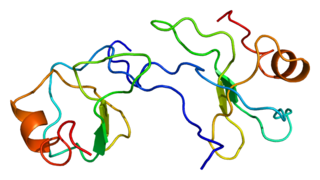 W
WChemokine ligand 3 (CCL3) also known as macrophage inflammatory protein 1-alpha (MIP-1-alpha) is a protein that in humans is encoded by the CCL gene.
 W
WChemokine ligand 5 is a protein which in humans is encoded by the CCL5 gene. It is also known as RANTES.
 W
WChemokine ligand 7 (CCL7) is a small cytokine known as a chemokine that was previously called monocyte-chemotactic protein 3 (MCP3). Due to CCL7 possessing two adjacent N-terminal cysteine residues in its mature protein, it is classified among the subfamily of chemokines known as CC chemokines. CCL7 specifically attracts monocytes, and regulates macrophage function. It is produced by certain tumor cell lines and by macrophages. This chemokine is located on chromosome 17 in humans, in a large cluster containing many other CC chemokines and is most closely related to CCL2.
 W
WChemokine ligand 8 (CCL8), also known as monocyte chemoattractant protein 2 (MCP2), is a protein that in humans is encoded by the CCL8 gene.
 W
WChemokine ligand 9 (CCL9) is a small cytokine belonging to the CC chemokine family. It is also called macrophage inflammatory protein-1 gamma (MIP-1γ), macrophage inflammatory protein-related protein-2 (MRP-2) and CCF18, that has been described in rodents. CCL9 has also been previously designated CCL10, although this name is no longer in use. It is secreted by follicle-associated epithelium (FAE) such as that found around Peyer's patches, and attracts dendritic cells that possess the cell surface molecule CD11b and the chemokine receptor CCR1. CCL9 can activate osteoclasts through its receptor CCR1 suggesting an important role for CCL9 in bone resorption. CCL9 is constitutively expressed in macrophages and myeloid cells. The gene for CCL9 is located on chromosome 11 in mice.
 W
WC-C motif chemokine 11 also known as eosinophil chemotactic protein and eotaxin-1 is a protein that in humans is encoded by the CCL11 gene. This gene is encoded on three exons and is located on chromosome 17.
 W
WChemokine ligand 12 (CCL12) is a small cytokine belonging to the CC chemokine family that has been described in mice. It is also known as monocyte chemotactic protein 5 (MCP-5) and, due to its similarity with the human chemokine MCP-1, sometimes it is called MCP-1-related chemokine. CCL12 specifically attracts eosinophils, monocytes and lymphocytes. This chemokine is found predominantly in lymph nodes and thymus under normal conditions, and its expression can be hugely induced in macrophages. It is thought to coordinate cell movements during early allergic reactions, and immune response to pathogens. The gene for CCL12 is found in a cluster of CC chemokines on mouse chromosome 11.
 W
WChemokine ligand 17 (CCL17) is a small cytokine belonging to the CC chemokine family is also known as thymus and activation regulated chemokine (TARC). CCL17 is expressed constitutively in thymus, but only transiently in phytohemagglutinin-stimulated peripheral blood mononuclear cells. This chemokine specifically binds and induces chemotaxis in T cells and elicits its effects by interacting with the chemokine receptor CCR4. The gene for CCL17 is located on chromosome 16, in humans, along with other chemokines called CCL22 and CX3CL1.
 W
WChemokine ligand 18 (CCL18) is a small cytokine belonging to the CC chemokine family. The functions of CCL18 have been well studied in laboratory settings, however the physiological effects of the molecule in living organisms have been difficult to characterize because there is no similar protein in rodents that can be studied. The receptor for CCL18 has been identified in humans only recently, which will help scientists understand the molecule's role in the body.
 W
WChemokine ligand 19 (CCL19) is a protein that in humans is encoded by the CCL19 gene.
 W
WChemokine ligand 20 (CCL20) or liver activation regulated chemokine (LARC) or Macrophage Inflammatory Protein-3 (MIP3A) is a small cytokine belonging to the CC chemokine family. It is strongly chemotactic for lymphocytes and weakly attracts neutrophils. CCL20 is implicated in the formation and function of mucosal lymphoid tissues via chemoattraction of lymphocytes and dendritic cells towards the epithelial cells surrounding these tissues. CCL20 elicits its effects on its target cells by binding and activating the chemokine receptor CCR6.
 W
WChemokine ligand 21 (CCL21) is a small cytokine belonging to the CC chemokine family. This chemokine is also known as 6Ckine, exodus-2, and secondary lymphoid-tissue chemokine (SLC). The gene for CCL21 is located on human chromosome 9. CCL21 elicits its effects by binding to a cell surface chemokine receptor known as CCR7.
 W
WC-C motif chemokine 22 is a protein that in humans is encoded by the CCL22 gene.
 W
WCerberus also known as CER1 is a protein that in humans is encoded by the CER1 gene. Cerberus is a signaling molecule which contributes to the formation of the head, heart and left and right asymmetry of internal organs. This gene varies slightly from species to species but its overall functions seem to be similar.
 W
WChemokines are a family of small cytokines, or signaling proteins secreted by cells. Their name is derived from their ability to induce directed chemotaxis in nearby responsive cells; they are chemotactic cytokines.
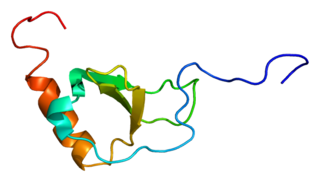 W
WFractalkine also known as chemokine ligand 1 is a protein that in humans is encoded by the CX3CL1 gene.
 W
WCX3C chemokine receptor 1 (CX3CR1) also known as the fractalkine receptor or G-protein coupled receptor 13 (GPR13) is a protein that in humans is encoded by the CX3CR1 gene. As the name suggests, this receptor binds the chemokine CX3CL1.
 W
WThe chemokine ligand 1 (CXCL1) is a small peptide belonging to the CXC chemokine family that acts as a chemoattractant for several immune cells, especially neutrophils or other non-hematopoietic cells to the site of injury or infection and plays an important role in regulation of immune and inflammatory responses. It was previously called GRO1 oncogene, GROα, neutrophil-activating protein 3 (NAP-3) and melanoma growth stimulating activity, alpha (MGSA-α). It's also known as keratinocytes-derived chemokine (KC) in mice or cytokine-induced neutrophil chemoattractant type-1 (CINC-1) in rats. In humans, this protein is encoded by the gene Cxcl1 and is located on human chromosome 4 among genes for other CXC chemokines.
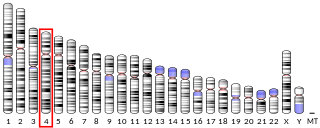 W
WChemokine ligand 3 (CXCL3) is a small cytokine belonging to the CXC chemokine family that is also known as GRO3 oncogene (GRO3), GRO protein gamma (GROg) and macrophage inflammatory protein-2-beta (MIP2b). CXCL3 controls migration and adhesion of monocytes and mediates its effects on its target cell by interacting with a cell surface chemokine receptor called CXCR2. More recently, it has been shown that Cxcl3 regulates cell autonomously the migration of the precursors of cerebellar granule neurons toward the internal layers of cerebellum, during the morphogenesis of cerebellum. Moreover, if the expression of Cxcl3 is reduced in cerebellar granule neuron precursors, this highly enhances the frequency of the medulloblastoma, the tumor of cerebellum. In fact, the reduced expression of Cxcl3 forces the cerebellar granule neuron precursors to remain at the surface of the cerebellum, where they highly proliferate under the stimulus of Sonic hedgehog, becoming target of transforming insults. Remarkably, the treatment with CXCL3 completely prevents the growth of medulloblastoma lesions in a Shh-type mouse model of medulloblastoma. Thus, CXCL3 is a target for medulloblastoma therapy. Cxcl3 is directly regulated transcriptionally by BTG2
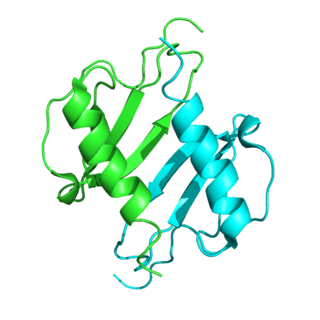 W
WC-X-C motif chemokine 5 is a protein that in humans is encoded by the CXCL5 gene.
 W
WChemokine ligand 7 (CXCL7) is a human gene.
 W
WChemokine ligand 9 (CXCL9) is a small cytokine belonging to the CXC chemokine family that is also known as monokine induced by gamma interferon (MIG). The CXCL9 is one of the chemokine which plays role to induce chemotaxis, promote differentiation and multiplication of leukocytes, and cause tissue extravasation.
 W
WC-X-C motif chemokine ligand 10 (CXCL10) also known as Interferon gamma-induced protein 10 (IP-10) or small-inducible cytokine B10 is an 8.7 kDa protein that in humans is encoded by the CXCL10 gene. C-X-C motif chemokine 10 is a small cytokine belonging to the CXC chemokine family.
 W
WC-X-C motif chemokine 11 (CXCL11) is a protein that in humans is encoded by the CXCL11 gene.
 W
WChemokine ligand 13 (CXCL13), also known as B lymphocyte chemoattractant (BLC) or B cell-attracting chemokine 1 (BCA-1), is a protein ligand that in humans is encoded by the CXCL13 gene.
 W
WChemokine ligand 15 (CXCL15) is a small cytokine belonging to the CXC chemokine family that has been described in the mouse. This chemokine is also known under the name lungkine. CXCL15 is an ELR+ CXC chemokine that recruits neutrophils during inflammation of the lungs. It is highly abundant in epithelial cells of the lung, and can also be found in other mucosal organs such as the urogenital and gastrointestinal tracts, and in endocrine organs like the adrenal gland. The gene for CXCL15 is found on mouse chromosome 5.
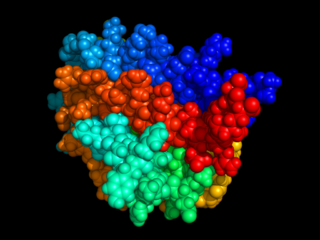 W
WErythropoietin, also known as erythropoetin, haematopoietin, or haemopoietin, is a glycoprotein cytokine secreted mainly by the kidney in response to cellular hypoxia; it stimulates red blood cell production (erythropoiesis) in the bone marrow. Low levels of EPO are constantly secreted sufficient to compensate for normal red blood cell turnover. Common causes of cellular hypoxia resulting in elevated levels of EPO include any anemia, and hypoxemia due to chronic lung disease.
 W
WGranulocyte colony-stimulating factor, also known as colony-stimulating factor 3, is a glycoprotein that stimulates the bone marrow to produce granulocytes and stem cells and release them into the bloodstream.
 W
WGranulocyte-macrophage colony-stimulating factor (GM-CSF), also known as colony-stimulating factor 2 (CSF2), is a monomeric glycoprotein secreted by macrophages, T cells, mast cells, natural killer cells, endothelial cells and fibroblasts that functions as a cytokine. The pharmaceutical analogs of naturally occurring GM-CSF are called sargramostim and molgramostim.
 W
WHepatocyte growth factor (HGF) or scatter factor (SF) is a paracrine cellular growth, motility and morphogenic factor. It is secreted by mesenchymal cells and targets and acts primarily upon epithelial cells and endothelial cells, but also acts on haemopoietic progenitor cells and T cells. It has been shown to have a major role in embryonic organ development, specifically in myogenesis, in adult organ regeneration, and in wound healing.
 W
WInflammasomes are cytosolic multiprotein oligomers of the innate immune system responsible for the activation of inflammatory responses. Activation and assembly of the inflammasome promotes proteolytic cleavage, maturation and secretion of pro-inflammatory cytokines interleukin 1β (IL-1β) and interleukin 18 (IL-18), as well as cleavage of Gasdermin-D. The N-terminal fragment resulting from this cleavage induces a pro-inflammatory form of programmed cell death distinct from apoptosis, referred to as pyroptosis, and is responsible for secretion of the mature cytokines, presumably through the formation of pores in the plasma membrane. In the case of dysregulation of inflammasome activation, an assortment of major diseases, such as cancer, autoimmune, metabolic and neurodegenerative diseases may arise.
 W
WInterferons are a group of signaling proteins made and released by host cells in response to the presence of several viruses. In a typical scenario, a virus-infected cell will release interferons causing nearby cells to heighten their anti-viral defenses.
 W
WInterferon beta-1a is a cytokine in the interferon family used to treat multiple sclerosis (MS). It is produced by mammalian cells, while interferon beta-1b is produced in modified E. coli. Some claims have been made that Interferons produce about an 18–38% reduction in the rate of MS relapses.
 W
WInterferon gamma (IFNγ) is a dimerized soluble cytokine that is the only member of the type II class of interferons. The existence of this interferon, which early in its history was known as immune interferon, was described by E. F. Wheelock as a product of human leukocytes stimulated with phytohemagglutinin, and by others as a product of antigen-stimulated lymphocytes. It was also shown to be produced in human lymphocytes. or tuberculin-sensitized mouse peritoneal lymphocytes challenged with PPD; the resulting supernatants were shown to inhibit growth of vesicular stomatitis virus. Those reports also contained the basic observation underlying the now widely employed interferon gamma release assay used to test for tuberculosis. In humans, the IFNγ protein is encoded by the IFNG gene.
 W
WHuman type I interferons (IFNs) are a large subgroup of interferon proteins that help regulate the activity of the immune system.
 W
WA sole member makes up the type II interferons (IFNs) that is called IFN-γ (gamma). Mature IFN-γ is an anti-parallel homodimer, which binds to the IFN-γ receptor (IFNGR) complex to elicit a signal within its target cell. IFNGR is made up of two subunits each of molecules designated IFNGR1 and IFNGR2.
 W
WThe interleukin-1 receptor antagonist (IL-1RA) is a protein that in humans is encoded by the IL1RN gene.
 W
WInterleukin 8 is a chemokine produced by macrophages and other cell types such as epithelial cells, airway smooth muscle cells and endothelial cells. Endothelial cells store IL-8 in their storage vesicles, the Weibel-Palade bodies. In humans, the interleukin-8 protein is encoded by the CXCL8 gene. IL-8 is initially produced as a precursor peptide of 99 amino acids which then undergoes cleavage to create several active IL-8 isoforms. In culture, a 72 amino acid peptide is the major form secreted by macrophages.
 W
WInterleukin-29 (IL-29) is a cytokine and it belongs to type III interferons group, also termed interferons λ (INF-λ). IL-29 plays an important role in the immune response against pathogenes and especially against viruses by mechanisms similar to type I interferons, but targeting primarily cells of epithelial origin and hepatocytes.
 W
WLeukemia inhibitory factor, or LIF, is an interleukin 6 class cytokine that affects cell growth by inhibiting differentiation. When LIF levels drop, the cells differentiate.
 W
WLymphotoxin-alpha (LT-α) or tumor necrosis factor-beta (TNF-β) is a protein that in humans is encoded by the LTA gene. Belonging to the hematopoietic cell line, LT-α exhibits anti-proliferative activity and causes the cellular destruction of tumor cell lines. As a cytotoxic protein, LT-α performs a variety of important roles in immune regulation depending on the form that it is secreted as. Unlike other members of the TNF superfamily, LT-α is only found as a soluble homotrimer, when found at the cell surface it is found only as a heterotrimer with LTβ.
 W
WLymphotoxin-beta (LT-beta) also known as tumor necrosis factor C (TNF-C) is a protein that in humans is encoded by the LTB gene.
 W
WThe colony stimulating factor 1 (CSF1), also known as macrophage colony-stimulating factor (M-CSF), is a secreted cytokine which causes hematopoietic stem cells to differentiate into macrophages or other related cell types. Eukaryotic cells also produce M-CSF in order to combat intercellular viral infection. It is one of the three experimentally described colony-stimulating factors. M-CSF binds to the colony stimulating factor 1 receptor. It may also be involved in development of the placenta.
 W
WMacrophage Inflammatory Proteins (MIP) belong to the family of chemotactic cytokines known as chemokines. In humans, there are two major forms, MIP-1α and MIP-1β that are now officially named CCL3 and CCL4, respectively. But we can sometimes encounter other names, especially in older literature, as LD78α, AT 464.1 and GOS19-1 for human CCL3 and AT 744, Act-2, LAG-1, HC21 and G-26 for human CCL4. But there are other macrophage inflammatory proteins aside from MIP-1. Namely MIP-2, MIP-3 and MIP-5.
 W
WNicotinamide phosphoribosyltransferase, formerly known as pre-B-cell colony-enhancing factor 1 (PBEF1) or visfatin for its extracellular form (eNAMPT), is an enzyme that in humans is encoded by the NAMPT gene. The intracellular form of this protein (iNAMPT) is the rate-limiting enzyme in the nicotinamide adenine dinucleotide (NAD+) salvage pathway that converts nicotinamide to nicotinamide mononucleotide (NMN) which is responsible for most of the NAD+ formation in mammals. iNAMPT can also catalyze the synthesis of NMN from phosphoribosyl pyrophosphate (PRPP) when ATP is present. eNAMPT has been reported to be a cytokine (PBEF) that promotes B cell maturation and inhibits neutrophil apoptosis.
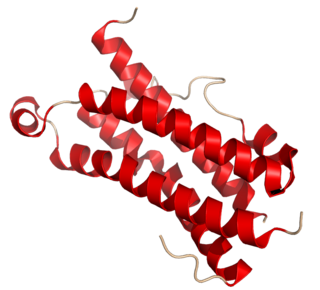 W
WOncostatin M, also known as OSM, is a protein that in humans is encoded by the OSM gene.
 W
WPlatelet factor 4 (PF4) is a small cytokine belonging to the CXC chemokine family that is also known as chemokine ligand 4 (CXCL4). This chemokine is released from alpha-granules of activated platelets during platelet aggregation, and promotes blood coagulation by moderating the effects of heparin-like molecules. Due to these roles, it is predicted to play a role in wound repair and inflammation. It is usually found in a complex with proteoglycan.
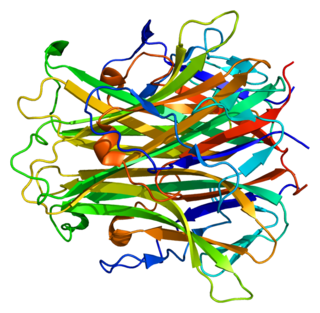 W
WReceptor activator of nuclear factor kappa-Β ligand (RANKL), also known as tumor necrosis factor ligand superfamily member 11 (TNFSF11), TNF-related activation-induced cytokine (TRANCE), osteoprotegerin ligand (OPGL), and osteoclast differentiation factor (ODF), is a protein that in humans is encoded by the TNFSF11 gene.
 W
WSickness behavior is a coordinated set of adaptive behavioral changes that develop in ill individuals during the course of an infection. They usually, but not always, accompany fever and aid survival. Such illness responses include lethargy, depression, anxiety, malaise, loss of appetite, sleepiness, hyperalgesia, reduction in grooming and failure to concentrate. Sickness behavior is a motivational state that reorganizes the organism's priorities to cope with infectious pathogens. It has been suggested as relevant to understanding depression, and some aspects of the suffering that occurs in cancer.
 W
WThe stromal cell-derived factor 1 (SDF1), also known as C-X-C motif chemokine 12 (CXCL12), is a chemokine protein that in humans is encoded by the CXCL12 gene on chromosome 10. It is ubiquitously expressed in many tissues and cell types. Stromal cell-derived factors 1-alpha and 1-beta are small cytokines that belong to the chemokine family, members of which activate leukocytes and are often induced by proinflammatory stimuli such as lipopolysaccharide, TNF, or IL1. The chemokines are characterized by the presence of 4 conserved cysteines that form 2 disulfide bonds. They can be classified into 2 subfamilies. In the CC subfamily, the cysteine residues are adjacent to each other. In the CXC subfamily, they are separated by an intervening amino acid. The SDF1 proteins belong to the latter group. CXCL12 signaling has been observed in several cancers. The CXCL12 gene also contains one of 27 SNPs associated with increased risk of coronary artery disease.
 W
WTumor necrosis factor is a cell signaling protein (cytokine) involved in systemic inflammation and is one of the cytokines that make up the acute phase reaction. It is produced chiefly by activated macrophages, although it can be produced by many other cell types such as T helper cells, natural killer cells, neutrophils, mast cells, eosinophils, and neurons. TNF is a member of the TNF superfamily, consisting of various transmembrane proteins with a homologous TNF domain.
 W
WThe tumor necrosis factor (TNF) superfamily is a protein superfamily of type II transmembrane proteins containing TNF homology domain and forming trimers. Members of this superfamily can be released from the cell membrane by extracellular proteolytic cleavage and function as a cytokine. These proteins are expressed predominantly by immune cells and they regulate diverse cell functions, including immune response and inflammation, but also proliferation, differentiation, apoptosis and embryogenesis.
 W
WVascular endothelial growth inhibitor (VEGI), also known as TNF-like ligand 1A (TL1A) and TNF superfamily member 15 (TNFSF15), is protein that in humans is encoded by the TNFSF15 gene. VEGI is an anti-angiogenic protein. It belongs to tumor necrosis factor (ligand) superfamily, where it is member 15. It is the sole known ligand for death receptor 3, and it can also be recognized by decoy receptor 3.
 W
WChemokine ligand (XCL1) is a small cytokine belonging to the C chemokine family that is also known as lymphotactin. Chemokines are known for their function in inflammatory and immunological responses. This family C chemokines differs in structure and function from most chemokines. There are only two chemokines in this family and what separated them from other chemokines is that they only have two cysteines; one N-terminal cysteine and one cysteine downstream. These both are called Lymphotactin, alpha and beta form, and claim special characteristics only found between the two. Lymphotactins can go through a reversible conformational change which changes its binding shifts.
 W
WThe "C" sub-family of chemokine receptors contains only one member: XCR1, the receptor for XCL1 and XCL2.